GO-SHIP I08S 2024: Weekly Update #1
The Trudging Forties
28 February 2024
Mobilization
Mobilization (loading and unloading) for I08S cruise occurred from Feb 17 to 21 at the Australian Marine Complex where R/V Thomas G Thompson was berthed, just south of Fremantle, Western Australia. Most of the science lab leads arrived at the ship on Feb 17, where equipment for the labs and and BGC floats was being delivered at the dock. Shipboard preparations included installing new roll up doors and testing the accordion system that will move the rosette to and from the starboard deck during the cruise. Lab setup continued indoors as much as possible as outdoor air temperature was routinely around 45°C during the day. According to temperature maps from Windy.com, Western Australia and the Perth area were the hottest spots in the world during our mobilization.
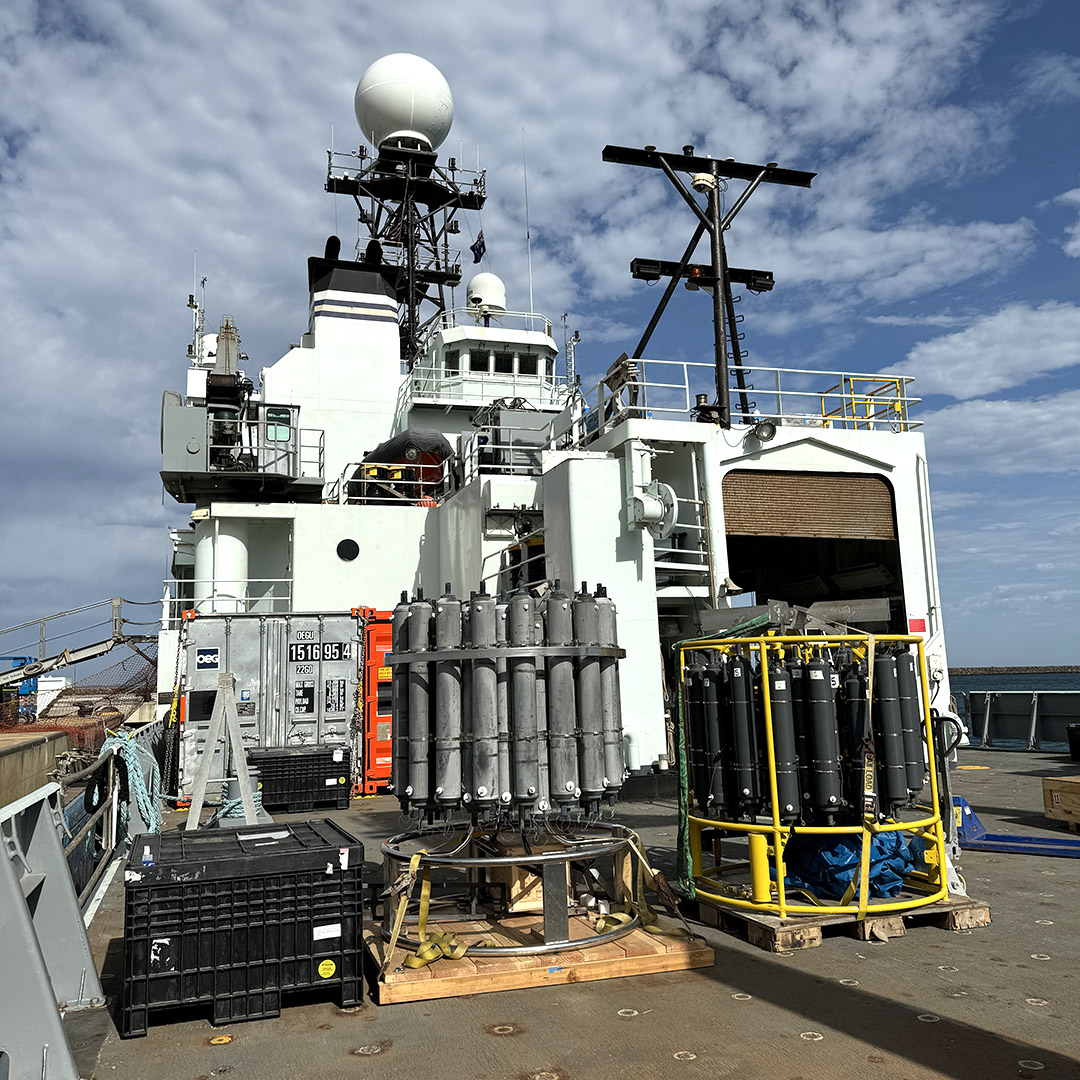
The CTD Rosette (plus a back-up) sit on the back deck of the R/V Thompson.
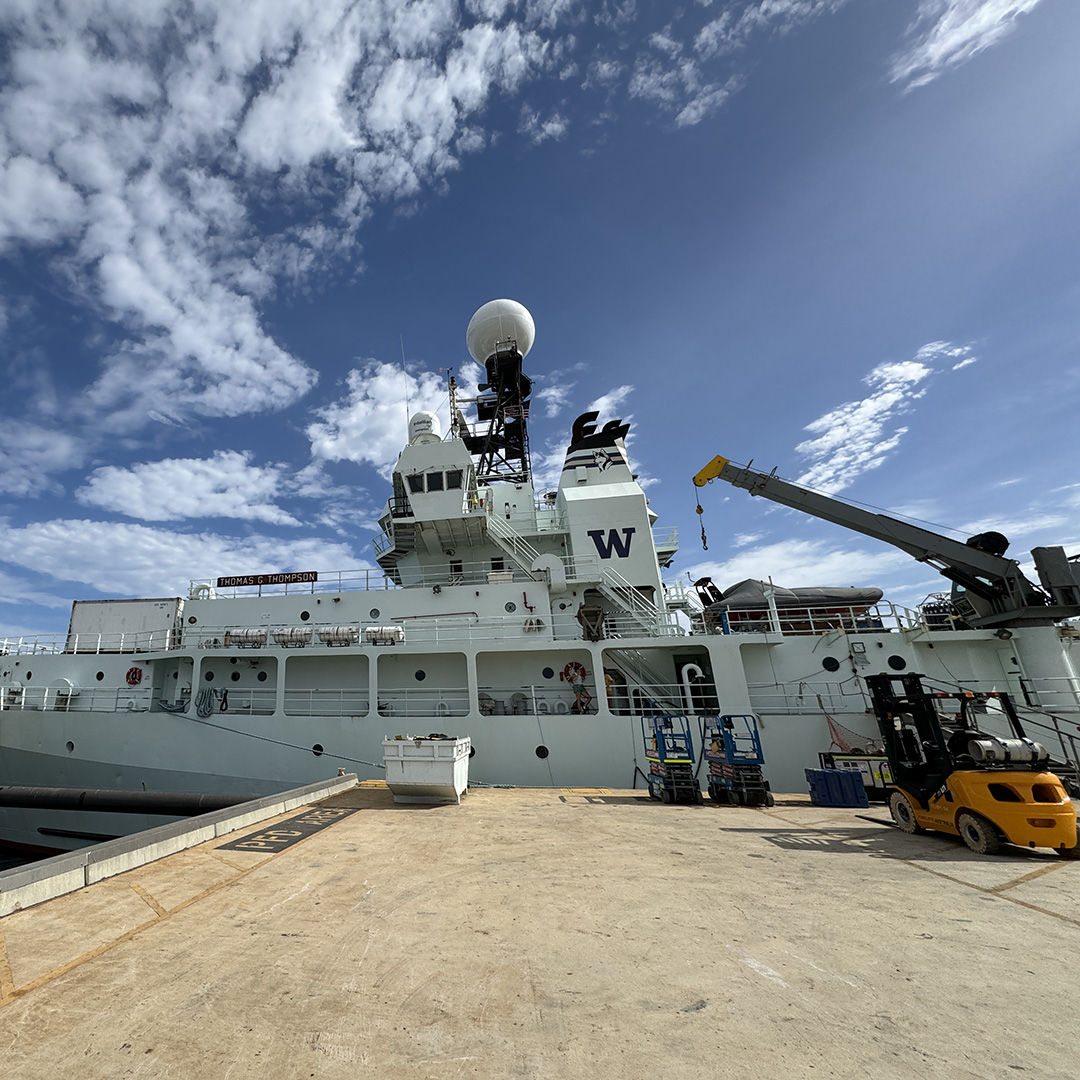
Shipments continued to arrive, and equipment was organized and secured right up until our departure.
A few shipments arrived in the later part of the mobilization, most notably the five different backup shipments coming from PMEL, AOML and UCSD for the DIC (Dissolved Inorganic Carbon) group. These were air shipments sent to replace the PMEL van lab which had been delayed in Singapore and would not make it on time in Fremantle for I08S. The final delivery of Nitrogen and pure air gas tanks for the DIC analytical lab arrived at the ship in the morning of Wednesday Feb 21, and the R/V Thompson set sail at 14:50 local (UTC +8), marking the start of the I08S 2024 cruise.
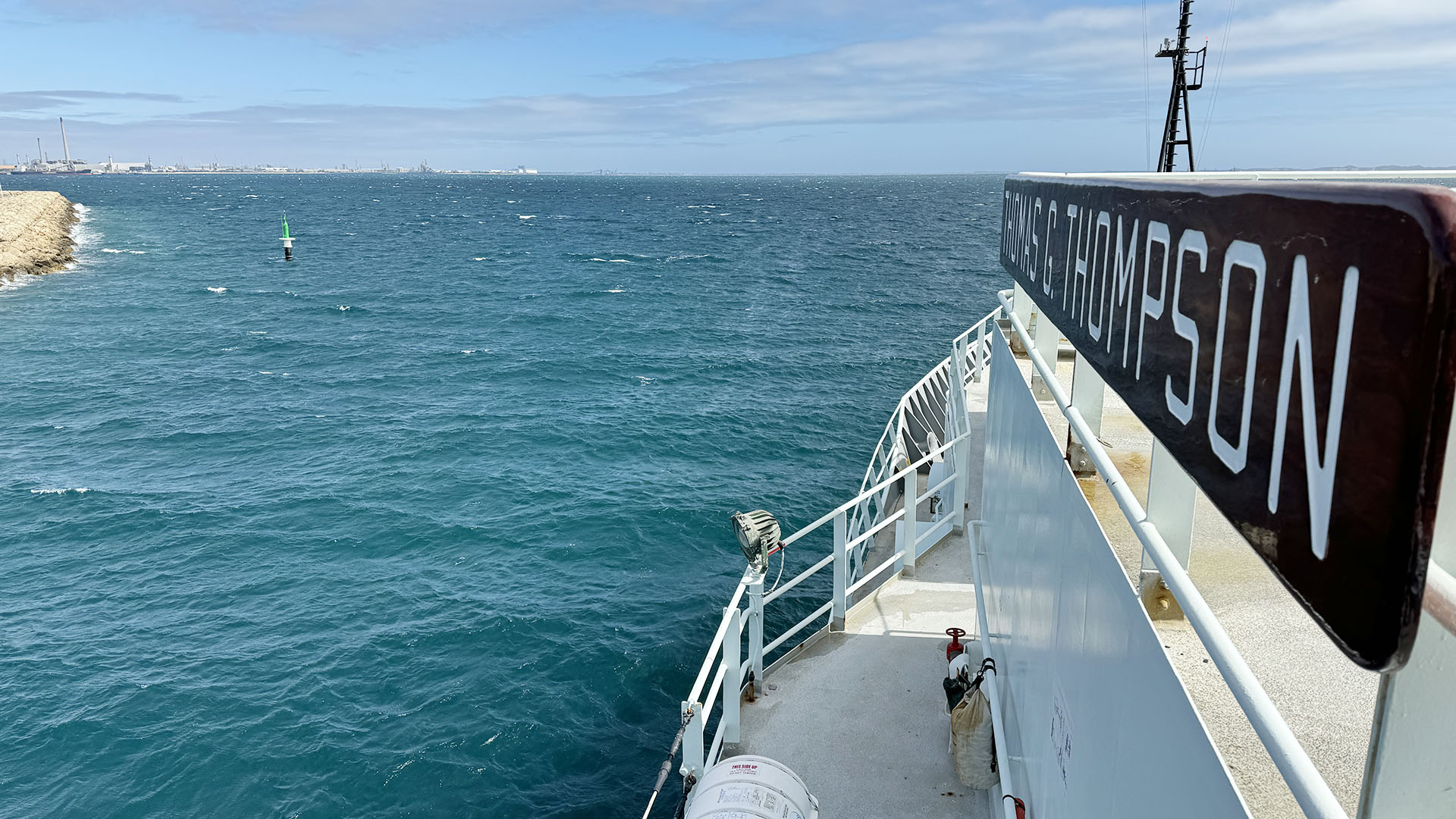
R/V Thompson sets sail from Fremantle, Western Australia.
Departure
As we crossed the western Australian shelf, the ship’s ADCP (Acoustic Doppler Current Profiler) mounted on the hull and thermosalinograph measured southward velocity and warm water temperatures inshore, consistent with the Leeuwin current with its warm tropical waters. Soon after departure, the Bio group started taking samples from the underway system (as permitted by research clearance from the Australian government). Since then, the Bio group has been busy continuing to collect underway samples for a suite of biological parameters at solar sunrise, noon, and sunset. On the second day of the cruise, fire drills were conducted in the morning and everyone in the science party donned their immersion or “Gumby” suits.
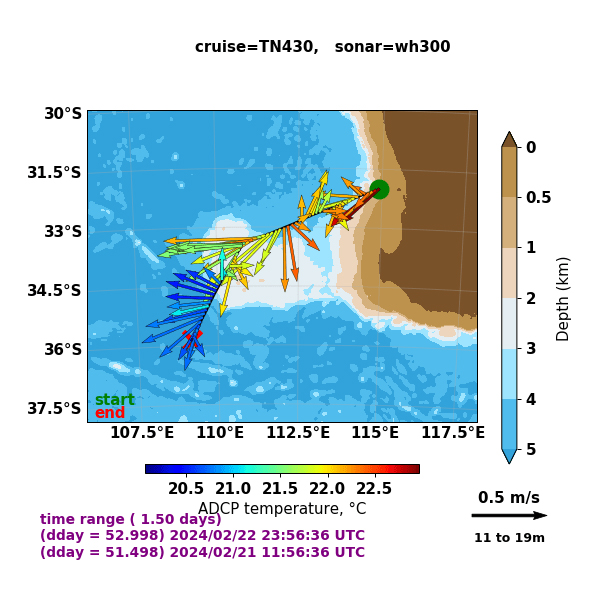
ADCP and thermosalinograph data collected underway as we departed from Fremantle.

Scientist Daniela Nestory dons her immersion suit during the safety drill.
Our first CTD (Conductivity, Temperature, Depth) test cast was done just outside the Australian EEZ. This test cast was successful, and every group practiced their sampling skills. The six CTD watchstanders learned to cock the 10.2-Liter Bullister bottles, draw water from them for salt samples, and practiced the CTD operation from the control room. This cast also allowed us to test the CTD and LADCP instruments, as well as the accordion system, and to gauge the sensitivity of the wire tension to the ship’s motion and sea state. After the test cast, the R/V Thompson continued its transit to the southwest at 12 knots for the next couple of days.
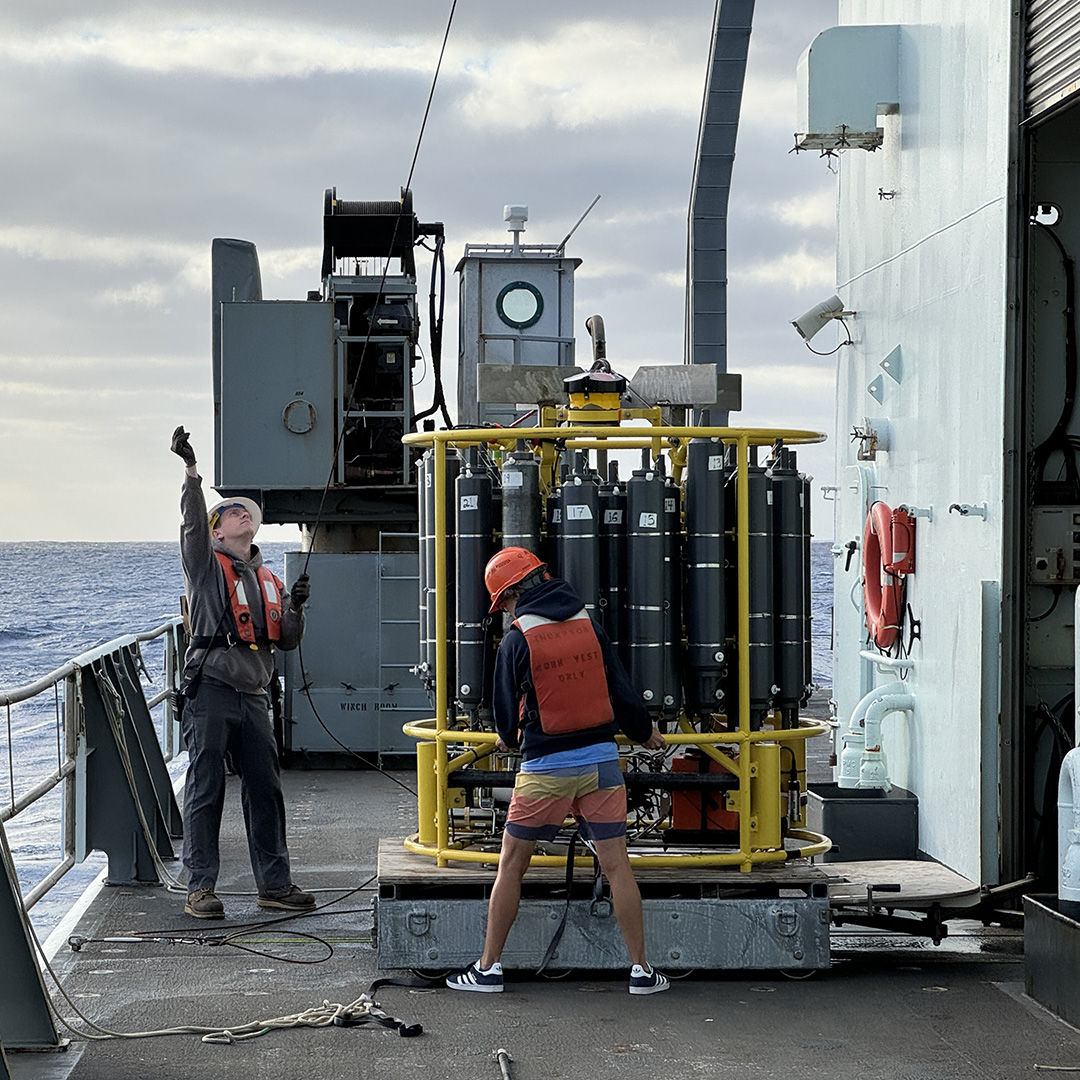
Marine Tech Emmett Dixon helps crew members maneuver the CTD into place on the platform.
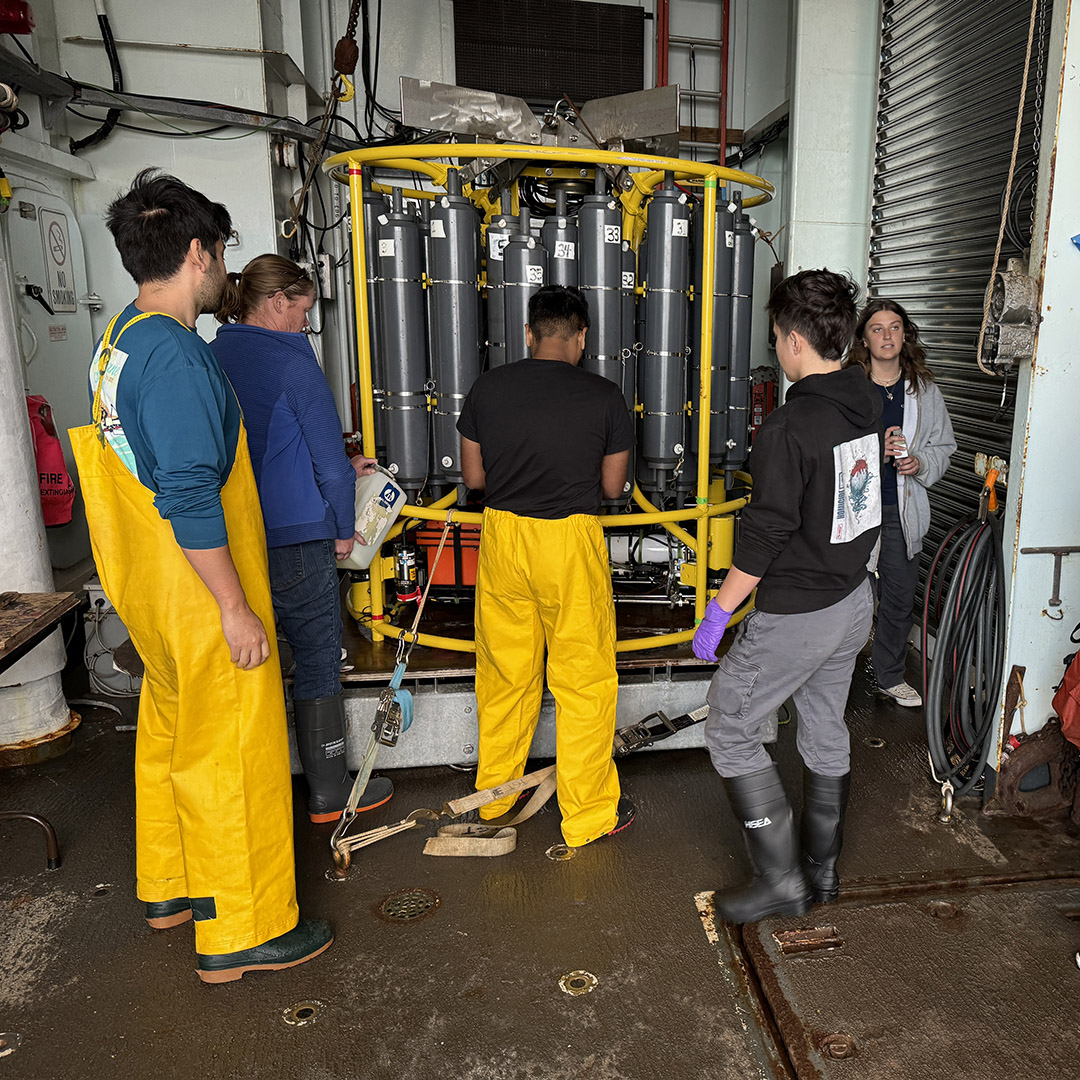
CTD watchstanders learn how to draw water from the Bullister bottle.
On Saturday Feb 24, Co-Chief Scientist Katelyn Schockman organized a science meeting in the ship’s library, where we learned a bit more about the GO-SHIP program, the circulation of the I08S cruise, an interesting CTD dataset from sensors mounted on seals, the principles of CFCs (Chlorofluorocarbons), details of the Argo float program, and proper etiquette for dog dating from two of our participants.
Weather Detour
In the early hours of Feb 25, the ship diverted west to avoid a weather system. As predicted by several weather models, this storm created seas with significant wave height of 30 ft around us and winds from 40 to 50 knots. Winds remained above 40 knots as a high pressure to our northwest kept pinching isobars across the South Indian Ocean for the past two days and seas were not coming down. So, here we were, stuck in the never-ending roaring forties, trudging west at less than 5 knots. Finally, conditions abated a bit, the ship turned southward, and we headed towards Antarctica with occasional rolls from the large westerly swell on our starboard bow. Unfortunately, stalling from this storm and more that are projected down south could delay our first CTD cast near Antarctica by up to four days, according to some estimates. Despite the detour, we were able to successfully deploy our first core Argo float along the transit.
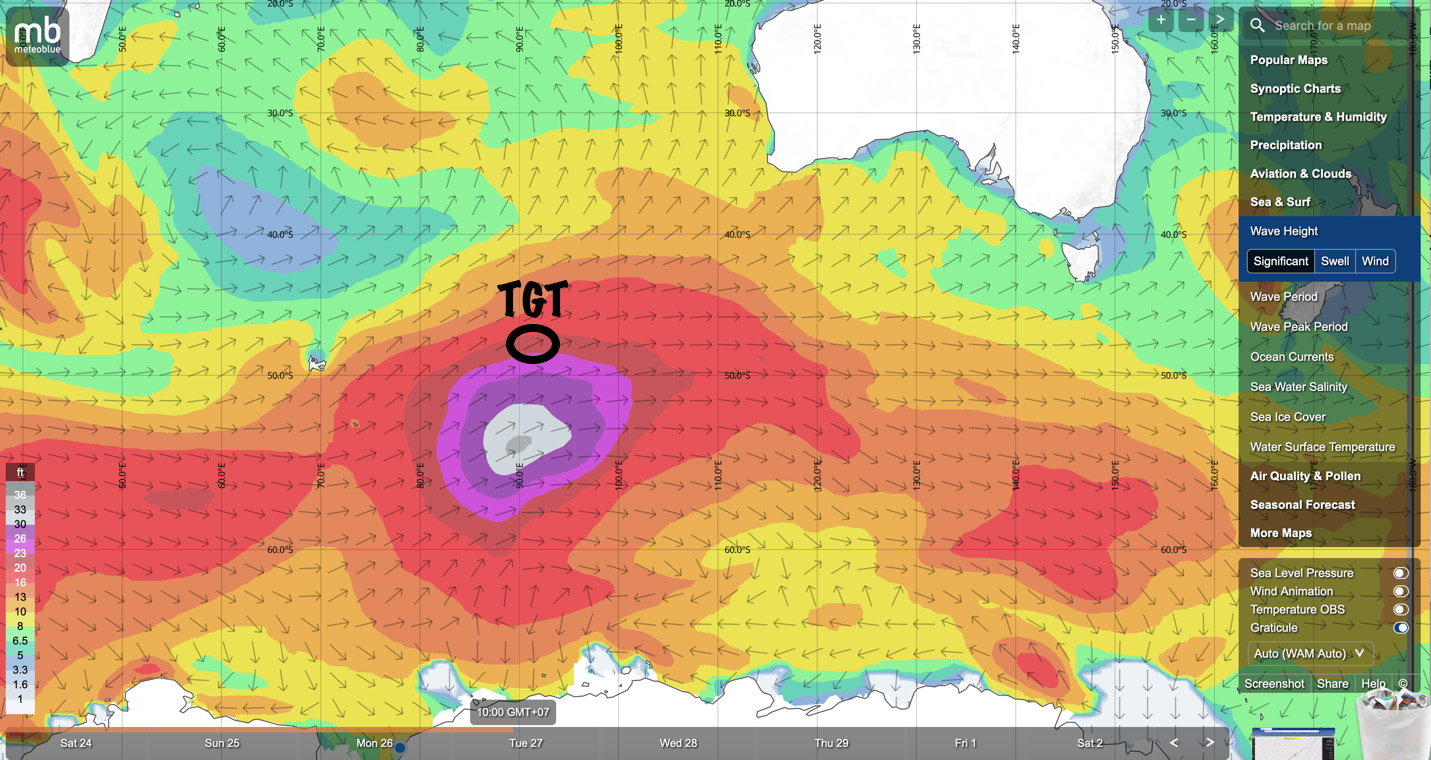
Map of significant wave height taken from Windy.com showing the large storm and location of the R/V Thompson (TGT).
Maintenance & Preparations
Apart from learning about the vicissitudes of the Indian Ocean, we have also learned a great deal about the maintenance of Bullister bottles by making new lanyards and replacing the existing ones. The DIC lab has been busy nonstop troubleshooting a wide gamut of issues— encompassing software, hardware, and plumbing, and all of this in heavy seas, which are creating instabilities in the instruments and complicating their fine setup.
So, everyone tries to keep busy indoors as decks are secured due to weather. Occasionally we have been allowed to peek outside the rear of the high bay during float or drifter deployments. To date, we’ve deployed three core Argo floats and one drifter. Thankfully, the food is really good and the science party is getting along well together.

The science party has been spending time getting to know each other during the transit, entertaining themselves with games and puzzles.
Until next time, so long and thanks for all the fish!
Seb Bigorre and Katelyn Schockman
A more detailed version of this Weekly Report is available on the US GO-SHIP website.
All images are by Jennifer Magnusson unless otherwise noted.
Glossary of Acronyms:
ODF – Oceanographic Data Facility at Scripps Institution of Oceanography
CFC – Chlorofluorocarbons; the Ocean Tracer group uses CFC and SF6 measurements to detect changes in water mass formation rates and to improve estimates of the uptake and storage of anthropogenic CO2 in the ocean on a global scale.
pH – A figure expressing the acidity or alkalinity of a solution
Talk – Total Alkalinity, a measurement of the water’s ability to resist a reduction in pH
Bio – Bio-GO-SHIP, an international collaboration to measure, understand, and predict the distribution and biogeochemical role of pelagic plankton communities.
BGC – Biogeochemical floats
SWAB test – Operation SWAB is run by the University of Miami Tritium Lab (UMTL). It is a program to help ensure that the US Academic Research Fleet (ARF) stays clean enough for background 14C and 3H sampling.
UNOLS – University-National Oceanographic Laboratory System is an organization of 58 academic institutions and National Laboratories involved in oceanographic research and joined for the purpose of coordinating oceanographic ships’ schedules and research facilities.
PMEL – NOAA’s Pacific Marine Environmental Laboratory is a federal laboratory that makes critical observations and conducts groundbreaking research to advance our knowledge of the global ocean and its interactions with the earth, atmosphere, ecosystems, and climate.
AOML – NOAA’s Atlantic Oceanographic and Meteorological Laboratory studies hurricanes, coastal ecosystems, oceans and human health, climate, global carbon, and how the ocean changes over time.
NOAA – National Oceanic and Atmospheric Administration
UCSD – University of California at San Diego which houses the Scripps Institution of Oceanography.
DIC – Dissolved inorganic carbon is involved in many of the acid-base reactions in soils and water.
ADCP – the shipboard Acoustic Doppler Current Profiler measures how fast water is moving across an entire water column.
CTD – Conductivity, Temperature, Depth; the CTD measures conductivity (which helps determine salinity), temperature, and depth throughout the water column. Our collects discrete water samples (at specific predetermined depths) using the rosette of Bullister/Niskin bottles.
LADCP – Lowered Acoustic Doppler Current Profiler; these 6000-meter pressure rated ADCP instruments are mounted on CTD frames, which provide the ability to measure full water column absolute velocity profiles just about anywhere on earth.
EEZ – Exclusive Economic Zone; an area of the sea in which a sovereign state has exclusive rights regarding the exploration and use of marine resources, including energy production from water and wind.
